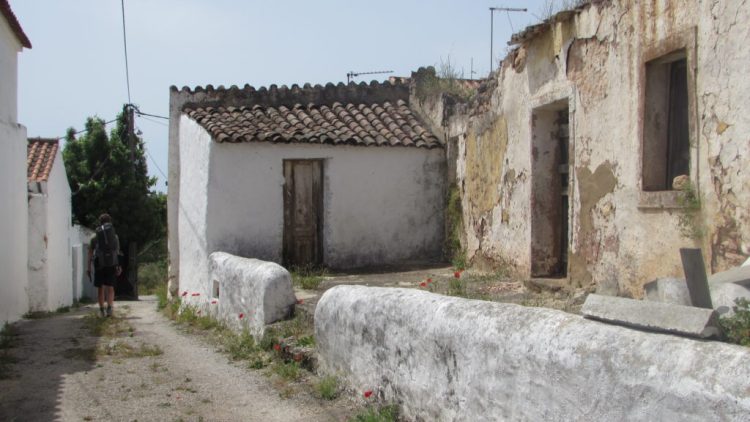
Now we were entering more populated areas, it seemed unlikely we’d have any problem finding a room for the night. We were pretty sure the German couple on the Alcoutim bus were hiking the trail – Antonio had described two heavily-equipped Germans who stopped at his bar in Corto Velho a day before us – but none of our overnight hosts had mentioned them so we guessed they must be wild camping.
Although we had parted company with the official Via Algarviana route to reach our hotel, Harri had made certain we followed the waymarked route during last night’s wanderings. This meant we could leave Hotel Alte via its rear entrance this morning and avoid an unnecessary descent into Alte (followed by a steep climb leading us back to square one!).

After climbing for a while, we were soon heading downhill on a track behind stone walls. There was scant opportunity to escape the sun’s rays and as the hours passed, the going got tougher. Today, the orange groves alongside us were unprotected and it would have been so easy to reach out and remove some of those juicy fruit from the trees except … unlike the abandoned nespera, pomegranate and carob orchards we had passed on previous days, these well-kept orange groves represented somebody’s hard work and livelihood. Taking even one orange from those trees would be akin to theft and neither of us were thieves.
We’d been looking forward to enjoying a beer at Portela, but the promised bar/café never materialised and it was only later that we realised the refreshment symbol marked on our online map probably referred to some plastic chairs outside a petrol station (presumably you popped inside to purchase your cans, then relaxed amid the petrol fumes!).

Once again, the heat was adversely affecting our progress. São Bartolomeu de Messines had been visible on the skyline for some time, but we didn’t seem to be getting any closer. A detour through the lush Meirinho valley provided some much-needed respite from the sun’s rays, even if it did mean our views were limited.
On the outskirts of Messines, we stumbled upon the pretty little chapel of Santuário Nossa Senhora da Saúde. Back in the sixteenth century this was the planned hilltop site for the parish church (Igreja Matriz); however, church leaders decreed that Messines’ main church should be built in the town itself.
The final descent into town was decidedly hairy and, had there been an alternative route, I’d certainly have taken it. As it was, Harri had to clamber down the steep and stony bank with his own belongings, then return first for my rucksack and then for me.

Having reached Messines, our priority was to get an ice-cold beer, and so it was a happy coincidence that the first establishment we spotted – the Café Academico – just happened to be next door to Bartholomeu Guesthouse, where we were staying.

Messines is a town with a population of around 8,000, so consequently it felt busier than other places we’d passed through, though not exactly bustling in the afternoon heat. The sixteenth-century parish church took centre-stage on what felt very much like a traffic island. The baroque facade with its red sandstone was added sometime during the eighteenth century, which explains the date – 1715 – over the door.
The poet João de Deus was born here in 1830 and is much revered in the town. João headed to Coimbra University to study law, where he then dedicated himself to writing poetry. There is a museum in Messines dedicated to his life and work.

Nothing we had seen all afternoon had hinted that this sleepy Algarve backwater would become a lively, thriving metropolis after dark where we would struggle to find a table for two; however, when we returned to the Café Academico for our evening meal, the place was packed to the rafters. You’ve guessed it. The football mad townsfolk of Messines were here en masse to watch a big match.
Fortunately, the lovely waiter found us two seats at the end of a table, and later, we were joined by six hikers from Belgium who were walking half the Via Algarviana on an organised trip (the lucky things had their rucksacks transported from one place to the next each day).
Enjoying the unexpected company, we stayed out much later than usual, but there was one thing I wanted to do before going to bed. Grabbing Harri’s hand, I urged him to climb the narrow staircase to the rooftop terrace. From our vantage point above the sloping terracotta roofs of neighbouring buildings, the town was bathed in the warm glow of street lights. Messines had treated us well this evening, all things considered.

For more information about walking the Via Algarviana visit the official website. A printed guide with individual maps of each section, plus all the link routes are available free of charge (postage is payable).
The Via Algarviana – an English guide to the ‘Algarve Way’ by Harri Garrod Roberts is available from online bookstores, included Amazon’s Kindle store and is priced at £2.99.
A ‘Made for iBooks’ version is also available from Apple’s iBookstore.
The Via Algarviana: walking 300km across the Algarve by Tracy Burton is available in paperback (£5.99) and Kindle edition (£2.99) from Amazon.
For more photographs of the Via Algarviana visit Pinterest.
Discover more from tracyburton.co.uk
Subscribe to get the latest posts sent to your email.
